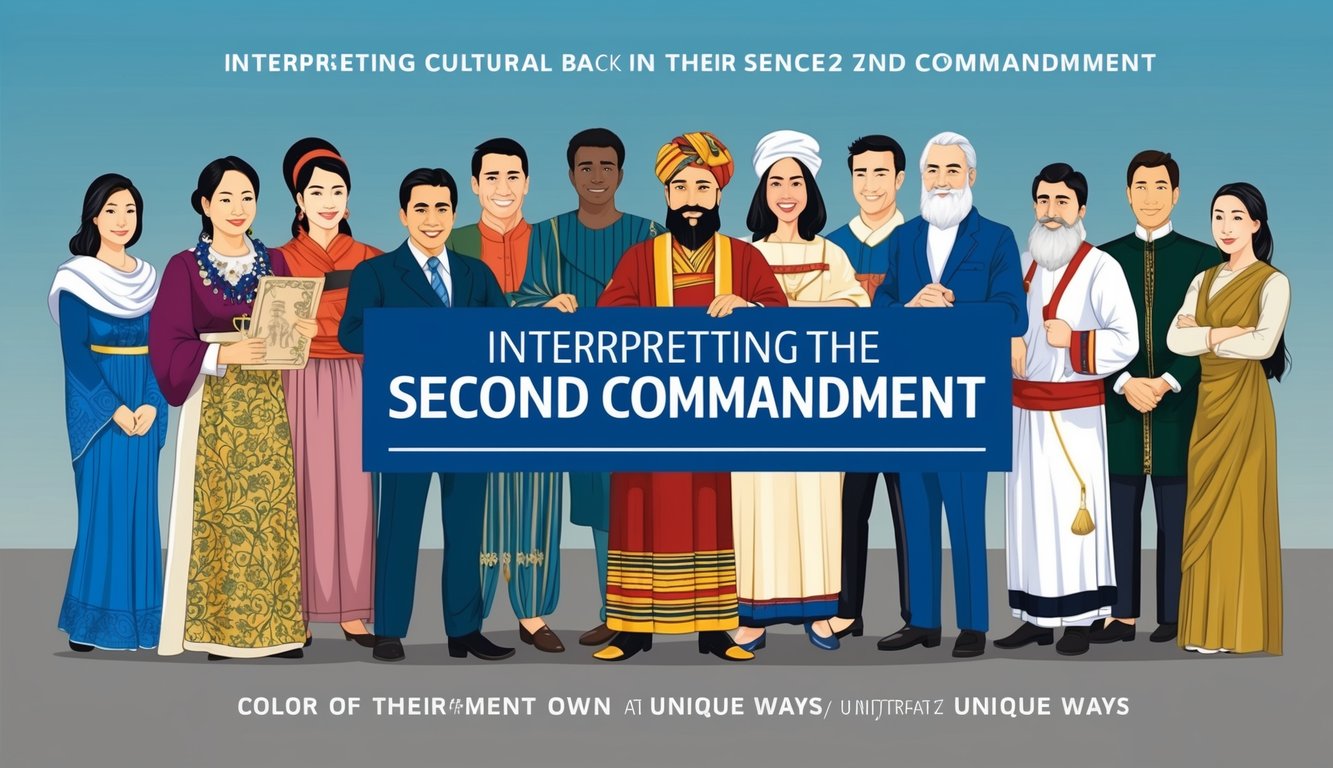Don’t Miss Out On This Unique Astrological Opportunity
Are you tired of spinning your wheels and getting nowhere? Simply put, you’re out of sync: you’re out of alignment with your astral configuration.
But: there’s a kind of map that can help you reclaim your alignment. Think of it as your own personal blueprint to success and happiness: a blueprint that will help you live your most amazing life.
Get started here.
When you think about the Ten Commandments, you might wonder what each one truly means.
The Second Commandment stands out because it addresses the importance of worship and how God should be revered. This commandment warns against making any graven images or idols and emphasizes the need for pure worship. It’s not just about statues or paintings; it’s about ensuring your heart and actions focus on God.
In a world filled with distractions, it’s easy to forget this fundamental guideline found in the Bible.
By reflecting on the Second Commandment, you can deepen your faith and understanding.
The significance of this commandment in your life is about maintaining a genuine relationship with God, free of distractions or misrepresentations.
This commandment is a cornerstone of Christianity and plays a crucial role in guiding your beliefs and worship practices.
As you explore its meaning, you’ll discover how it can influence your daily choices and spiritual life.
Understanding how this fits into the broader context of the Bible and your faith journey can lead to meaningful growth.
Exploring the Second Commandment
In Christianity, the Second Commandment focuses on prohibiting the making of idols and worshipping them.
It emphasizes the importance of honoring God without the use of physical representations.
Historical Context
The Second Commandment was given to Moses on Mount Sinai and was part of the Ten Commandments, crucial for the Israelites.
At that time, they were transitioning from Egyptian captivity, where idol worship was common.
The commandment was God’s way of guiding them toward exclusive worship of Him.
You see, idol worship was rampant in ancient cultures.
The Israelites needed to distinguish themselves as followers of one God.
This commandment was essential for maintaining their identity and faith.
Textual Details
The commandment states: “Thou shalt not make unto thee any graven image.” It advises against creating images or idols to represent God, focusing on spiritual rather than physical worship.
This commandment underscores the Israelites’ commitment to God, promoting faith through prayer and worship, not through man-made idols.
In essence, God wanted people to connect with Him directly.
Idol creation was seen as limiting God’s infinite nature to a physical object.
This remains significant in understanding the intent behind worship and devotion.
This aspect of the commandment is still relevant today in many Christian teachings.
Theological Significance
The Second Commandment holds deep meaning in Christianity, emphasizing how believers should approach worship and view God’s nature.
It explores the dangers of idolatry and the importance of respecting the divine and invisible aspects of the godhead.
Idolatry and Worship
Idolatry is a central concern in the Second Commandment.
It warns against creating and worshipping “graven images” or any likeness of things in heaven or earth.
This involves trusting in these images as a representation of the divine, which can distract from true worship.
In Christianity, idolatry extends beyond physical images.
It includes anything that takes God’s place in your heart and mind.
Whether it’s material possessions, power, or even relationships, the commandment reminds you to prioritize God above all.
The Holy Spirit plays a role in guiding you away from idolatry.
By relying on the Holy Spirit, you seek to understand and connect with God without the need for physical representations.
This ensures worship remains focused on God’s true, invisible nature.
God’s Nature and the Commandment
The Second Commandment sheds light on God’s nature, emphasizing how God is beyond physical forms.
God is described as invisible, capturing the divine essence and separating it from earthly representations.
This commandment encourages recognizing the uniqueness of the godhead, including Jesus Christ.
By avoiding visual depictions, you maintain reverence for the mysterious and holy aspects of God.
This approach highlights the transcendent and infinite nature of God.
The commandment reminds you of God’s vastness and incomparability to any creature.
This understanding fosters a deeper respect and appreciation for the divine, inspiring a closer spiritual relationship.
Cultural Impact and Interpretations

The Second Commandment has shaped various religious practices and artistic expressions.
Understanding how different cultures and religions interpret this commandment sheds light on its influence through history.
Many iconoclastic movements, for example, have stemmed from strict interpretations of this commandment, leading to periods of religious reform and artistic restriction.
Conversely, some traditions have embraced symbolic representations while still adhering to the commandment’s core principles.
The Ten Commandments historical impact is evident in religious debates, legal frameworks, and artistic traditions across centuries.
The Commandment in Jewish Tradition
In Judaism, the Second Commandment primarily warns against idolatry.
You might notice that Jewish tradition has historically placed great emphasis on the prohibition of graven images.
This is evident in the way Jewish law often opposes creating images, especially of divine figures.
This restriction helped form a distinctive cultural identity, focusing on scripture and oral traditions over visual depictions.
The story of the Golden Calf is often cited, reflecting the commandment’s crucial role in Jewish history.
Christian Perspectives
Christian interpretation can vary between denominations.
Many Protestant groups, influenced by Lutheran teachings, view this commandment as a guide against idolatry and emphasize direct worship without intermediaries.
For Catholics and Orthodox Christians, icons are not seen as idols but rather as windows to the divine.
The Reformation caused a split in beliefs about images, leading some Protestant groups to adopt iconoclastic practices, removing images from worship spaces.
Influence on Art and Iconography
The commandment’s influence extends to the realm of art and iconography.
In Jewish culture, visual art has historically avoided depicting God or living creatures, focusing instead on abstract designs and calligraphy.
In Christianity, particularly in the Byzantine and Orthodox churches, religious art flourished through icons, seen as important devotional tools.
In contrast, some Protestant traditions, especially during the Reformation, embraced iconoclasm, which led to the removal or destruction of religious images in line with their interpretation of the commandment.
Modern Applications and Challenges

Understanding the second commandment in today’s world involves looking at how digital advancements and artistic expressions intersect with religious practices and beliefs.
It also involves finding a balance between maintaining respect for sacred traditions and adapting to modern contexts.
Faith in the Digital Age
In our digital world, technology plays a huge role in how you engage with your faith.
Online worship settings provide access to spiritual content anytime, anywhere.
This can strengthen your connection to faith communities.
At the same time, the vast amount of information and images available can be overwhelming.
When it comes to religious images and representations, the internet offers endless visuals.
This raises questions about adhering to the commandment, which warns against the creation and worship of idols.
You might find yourself navigating this challenge by learning the intent behind digital content and its alignment with your beliefs.
Balancing technology with traditional practices helps you embrace its benefits while staying true to your faith.
Balancing Reverence and Expression
Incorporating modern elements into worship settings allows for personal expression.
This can enhance your connection to faith.
Whether through music, art, or other creative mediums, many find that contemporary expressions bring additional meaning to traditional practices.
However, this comes with the challenge of maintaining reverence.
The line between sincere worship and casual representation can become blurred.
As you navigate this space, it’s important to consider how these expressions fit within the wider cultural and religious context.
Engaging in discussions within your community can help you explore new ways to express devotion while respecting biblical teachings.
Living the Second Commandment

Living the Second Commandment involves loving your neighbor as yourself.
This practice encourages personal growth and influences how communities worship together, fostering unity and faith.
Personal Reflection and Growth
Reflecting on the Second Commandment invites you to examine your heart and motivations.
Loving others genuinely requires respect and empathy, seeing them as equals.
Personal growth emerges from understanding this love is not just a feeling, but a call to action.
Spend time in prayer or meditation, asking for guidance on how to love others like yourself.
Reflect on past interactions and consider ways to improve them.
This internal journey is vital, as it shapes how you behave toward others, aligning your actions with your values.
Seeking obedience to this commandment transforms your life.
It involves regularly assessing how you treat others and striving to improve.
Embrace opportunities for growth, because loving others deeply enriches your life and deepens your spiritual understanding.
Community and Worship Practices
In the community, the Second Commandment inspires practices that promote unity and service.
Churches can incorporate teachings that encourage members to help and lift each other in everyday life, creating a strong supportive network.
Participate in group activities that promote community well-being.
Volunteering or attending communal worship sessions that focus on love and respect strengthens community bonds.
Worship practices like shared prayer and song cultivate a sense of coram deo, living in the presence of God.
Encourage open discussions about the importance of the Second Commandment, emphasizing its role in daily life.
This engages the community in a shared mission of living by this guiding principle.
Build a community where love and reverence for each other are central values.



